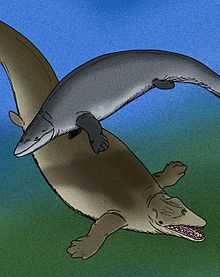Supayacetus
| Supayacetus Temporal range: Middle Eocene, 37Ma | |
|---|---|
 | |
| Ocucajea (top), S. muizoni (below) | |
| Scientific classification | |
| Kingdom: | Animalia |
| Phylum: | Chordata |
| Class: | Mammalia |
| Order: | Artiodactyla |
| Infraorder: | Cetacea |
| Family: | †Basilosauridae |
| Genus: | †Supayacetus Uhen et al. 2011 |
| Species: | † S. muizoni |
| Binomial name | |
| Supayacetus muizoni Uhen et al. 2011 | |
Supayacetus (after Supay, the Incan god of death, and ketos Greek for whale)[1] is an extinct genus of basilosaurid cetacean from Middle Eocene (Bartonian stage) deposits of southern Peru.
Supayacetus is known from the holotype MUSM 1465, a partial skeleton. It was collected in the Archaeocete Valley site, from the Paracas Formation of the Pisco Basin about 37 million years ago. It was named by Uhen et al. 2011 and the type species S. muizoni honours palaeontologist Christian de Muizon who has contributed considerably to Peruvian palaeontology.[2]
Distinguishing characters of Supayacetus include: a T-shaped manubrium with a rod-shaped process; cheek teeth with accessory denticles; a broad scapula with a large infraspinous fossa; humerus with large and hemispherical head, well-defined proximal tuberosities, a long deltopectoral crest, and a broad shaft. Compared to other basilosaurids, Supayacetus is larger than Protocetus but its skull and vertebrae are smaller than in other basilosaurids. [3]
Notes
- ↑ Uhen et al. 2011, Etymology, p. 960
- ↑ Uhen et al. 2011, Etymology, p. 963
- ↑ Uhen et al. 2011, Diagnosis, p. 960
References
- Uhen, Mark D.; Pyenson, Nicholas D.; Devries, Thomas J.; Urbina, Mario; Renne, Paul R. (2011). "New Middle Eocene Whales from the Pisco Basin of Peru". Journal of Paleontology 85 (5): 955–69. doi:10.1666/10-162.1. OCLC 802202947. Retrieved July 2013.
| ||||||||||||||||||||||||||||||||||||||||||||||||||